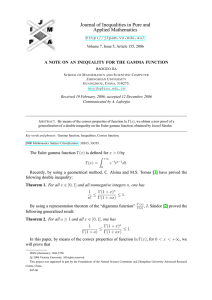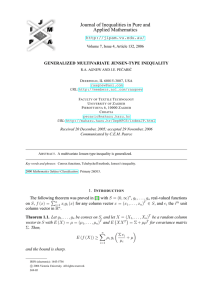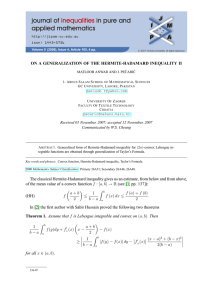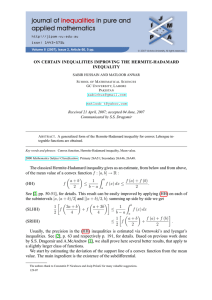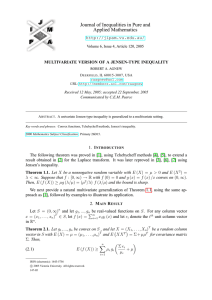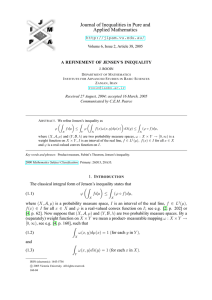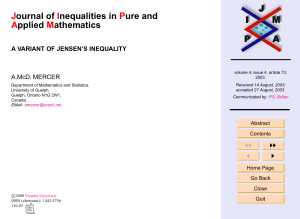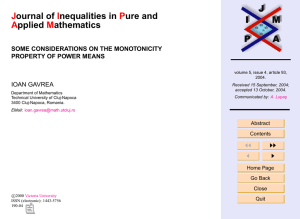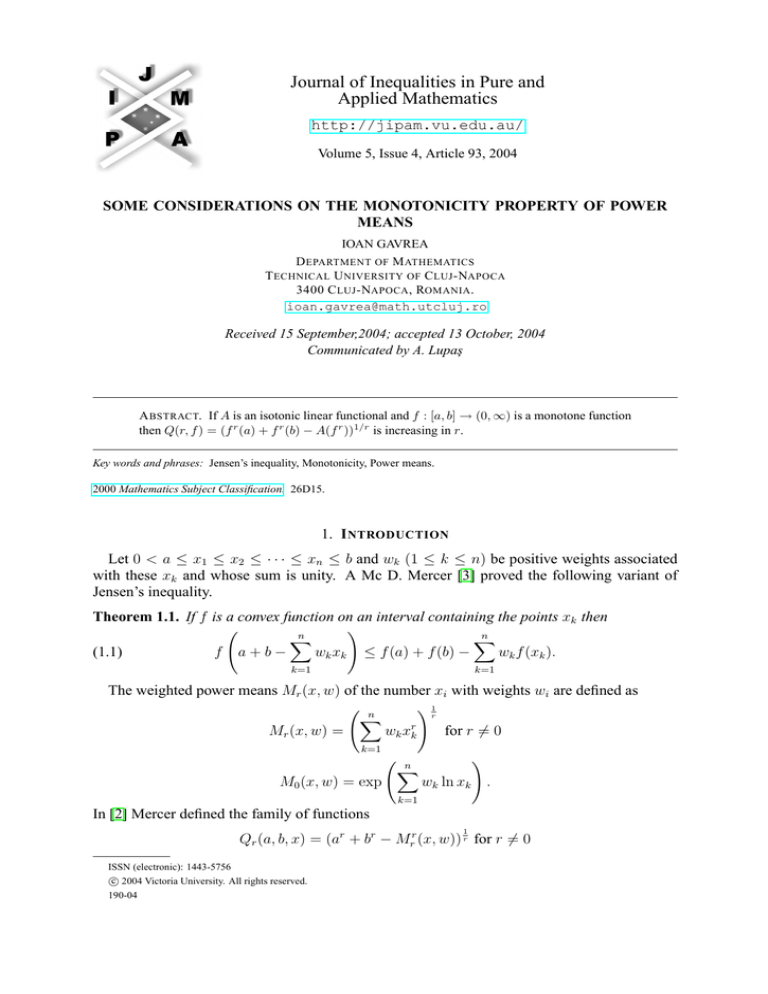
Journal of Inequalities in Pure and
Applied Mathematics
http://jipam.vu.edu.au/
Volume 5, Issue 4, Article 93, 2004
SOME CONSIDERATIONS ON THE MONOTONICITY PROPERTY OF POWER
MEANS
IOAN GAVREA
D EPARTMENT OF M ATHEMATICS
T ECHNICAL U NIVERSITY OF C LUJ -NAPOCA
3400 C LUJ -NAPOCA , ROMANIA .
ioan.gavrea@math.utcluj.ro
Received 15 September,2004; accepted 13 October, 2004
Communicated by A. Lupaş
A BSTRACT. If A is an isotonic linear functional and f : [a, b] → (0, ∞) is a monotone function
then Q(r, f ) = (f r (a) + f r (b) − A(f r ))1/r is increasing in r.
Key words and phrases: Jensen’s inequality, Monotonicity, Power means.
2000 Mathematics Subject Classification. 26D15.
1. I NTRODUCTION
Let 0 < a ≤ x1 ≤ x2 ≤ · · · ≤ xn ≤ b and wk (1 ≤ k ≤ n) be positive weights associated
with these xk and whose sum is unity. A Mc D. Mercer [3] proved the following variant of
Jensen’s inequality.
Theorem 1.1. If f is a convex function on an interval containing the points xk then
!
n
n
X
X
(1.1)
f a+b−
wk xk ≤ f (a) + f (b) −
wk f (xk ).
k=1
k=1
The weighted power means Mr (x, w) of the number xi with weights wi are defined as
! r1
n
X
for r 6= 0
Mr (x, w) =
wk xrk
k=1
M0 (x, w) = exp
n
X
!
wk ln xk
.
k=1
In [2] Mercer defined the family of functions
1
Qr (a, b, x) = (ar + br − Mrr (x, w)) r for r 6= 0
ISSN (electronic): 1443-5756
c 2004 Victoria University. All rights reserved.
190-04
2
I OAN G AVREA
Q0 (a, b, x) =
ab
M0
and proved the following (see also [4]):
Theorem 1.2. For r < s, Qr (a, b, x) ≤ Qs (a, b, x).
In [3] are given another proofs of the above theorems.
Let us consider a isotonic linear functional A, i.e., a functional A : C[a, b] → R with the
properties:
(i) A(tf + sg) = tA(f ) + sA(g) for t, s ∈ R, f, g ∈ C[a, b];
(ii) A(f ) ≥ 0 of f (x) ≥ 0 for all x ∈ [a, b].
In [1] A. Lupaş proved the following result:
“If f is a convex function and A is an isotonic linear functional with A(e0 ) = 1, then
(1.2)
f (a1 ) ≤ A(f ) ≤
(b − a1 )f (a) + (a1 − a)f (b)
,
b−a
where ei : [a, b] → R, ei (x) = xi and a1 = A(e1 ).
Let A be an isotonic linear functional defined on C[a, b] such that A(e0 ) = 1. For a real
number r and positive function f , f ∈ C[a, b] we define the power mean of order r as
1
(A(f r )) r
for r 6= 0
(1.3)
M (r, f ) =
exp (A(log f )) for r = 0
and for every monotone function f : [a, b] → (0, ∞)
1
(f r (a) + f r (b) − M r (r, f )) r ,
(1.4)
Q(r; f ) =
f (a)f (b) ,
exp(A(log f ))
r 6= 0
.
r=0
2. M AIN RESULTS
Our main results are given in the following theorems. Let A be an isotonic linear functional
defined on C[a, b] such that A(e0 ) = 1.
Theorem 2.1. Let f be a convex function on [a, b]. Then
(2.1)
f (a + b − a1 ) ≤ A(g) ≤ f (a) + f (b) − f (a)
b − a1
a1 − a
− f (b)
b−a
b−a
≤ f (a) + f (b) − A(f ),
where g = f (a + b − ·).
Theorem 2.2. Let r, s ∈ R such that r ≤ s. Then
Q(r, f ) ≤ Q(s, f ),
(2.2)
for every monotone positive function.
Proof of Theorem 2.1. The function g is a convex function. From inequality (1.2), written for
the function g we get:
(2.3)
f (a + b − a1 ) ≤ A(g) ≤
J. Inequal. Pure and Appl. Math., 5(4) Art. 93, 2004
(b − a1 )f (b) + (a1 − a)f (a)
.
b−a
http://jipam.vu.edu.au/
S OME C ONSIDERATIONS ON THE M ONOTONICITY P ROPERTY OF P OWER M EANS
3
Using Hadamard’s inequality (1.2) relative to the function f we obtain
A(f ) ≤ f (a)
(2.4)
b − a1
a1 − a
+ f (b)
.
b−a
b−a
However,
(2.5)
b − a1
a1 − a
(b − a1 )f (b) + (a1 − a)f (a)
= f (a) + f (b) − f (a)
− f (b)
.
b−a
b−a
b−a
Now (2.1) follows by (2.5), (2.4) and (2.3).
Proof of Theorem 2.2. Let us denote α = f r (a), β = f r (b). If 0 < r < s then the function
g(x) = xs/r is convex. Let us consider the following isotonic linear functional B : C[α, β] → R
defined by B(h) = A(h ◦ f r ), where α = min(f r (a), f r (b)), β = max(f r (a), f r (b)). We have:
B(e1 ) = A(f r ).
From (2.1) we get
g(α + β − B(e1 )) ≤ g(α) + g(β) − B(g)
or
(f (a)r + f r (b) − A(f )r )s/r ≤ f s (a) + f s (b) − A(f s ).
The last inequality is equivalent to
Q(r, f ) ≤ A(s, f ).
For r < s < 0, g is concave and we obtain
(f r (a) + f r (b) − A(f r ))s/r ≥ f s (a) + f s (b) − A(f s )
which is also equivalent to Q(r, f ) ≤ Q(s, f ). Finally, applying (2.1) to the concave function
log x for the functional
B(g) = A(g ◦ f r ),
we have
log (α + β − A(f r )) ≥ log α + log β − A (log f r ) ,
or
r log(Q(r, f )) ≥ r log Q(0, f ),
which shows that for r > 0
Q(−r, f ) ≤ Q(0, f ) ≤ Q(r, f ).
Remark 2.3. For the functional A, A : C[a, b] → R defined by
A(f ) =
n
X
wk f (xk ),
k=1
in the particular case when f (x) = xr we obtain Theorem 1.2.
J. Inequal. Pure and Appl. Math., 5(4) Art. 93, 2004
http://jipam.vu.edu.au/
4
I OAN G AVREA
R EFERENCES
[1] A. LUPAŞ, A generalization of Hadamard’s inequalities for convex functions, Univ. Beograd Publ.
Elektro. Fak., 544-579 (1976), 115–121.
[2] A. Mc D. MERCER, A monotonicity property of power means, J. Ineq. Pure and Appl. Math., 3(3)
(2002), Article 40. [ONLINE: http://jipam.vu.edu.au/article.php?sid=192]
[3] A. Mc D. MERCER, A variant of Jensen’s inequality, J. Ineq. Pure and Appl. Math., 4(4) (2003),
Article 73. [ONLINE: http://jipam.vu.edu.au/article.php?sid=314]
[4] A. WITKOWSKI, A new proof of the monotonicity property of power means, J. Ineq. Pure
and Appl. Math., 5(3) (2004), Article 73. [ONLINE: http://jipam.vu.edu.au/article.
php?sid=425]
J. Inequal. Pure and Appl. Math., 5(4) Art. 93, 2004
http://jipam.vu.edu.au/

